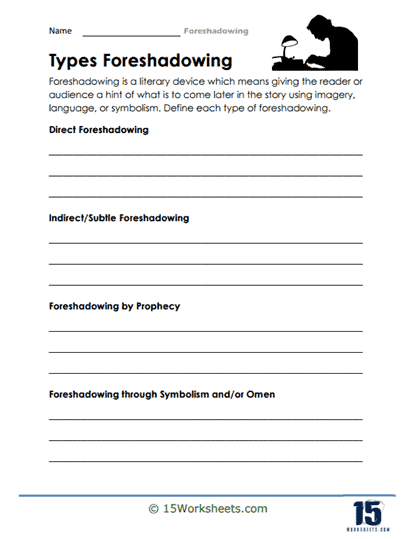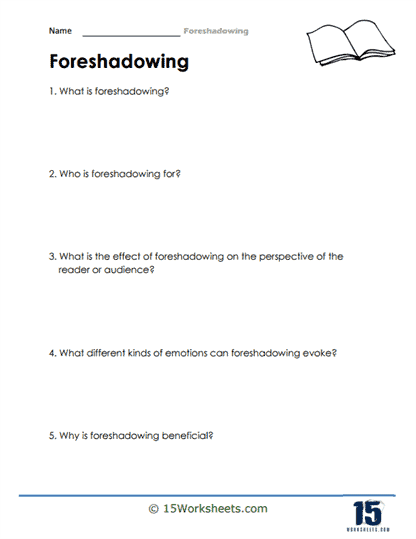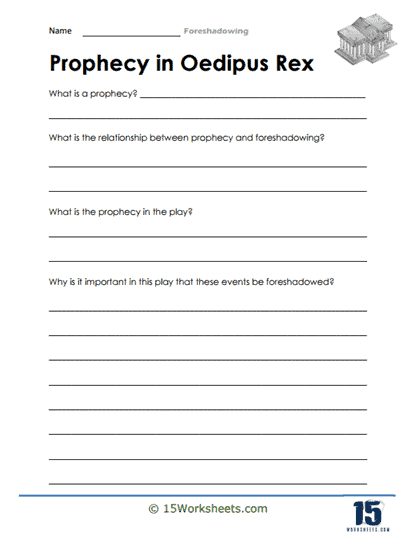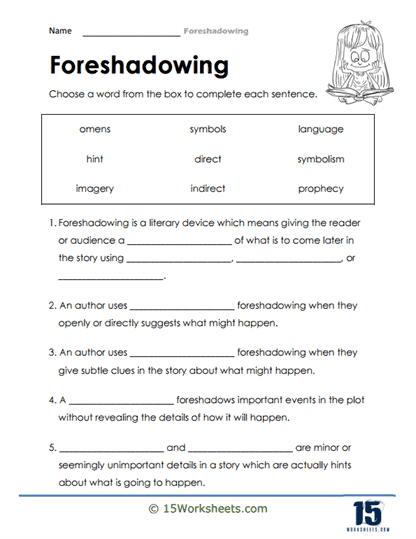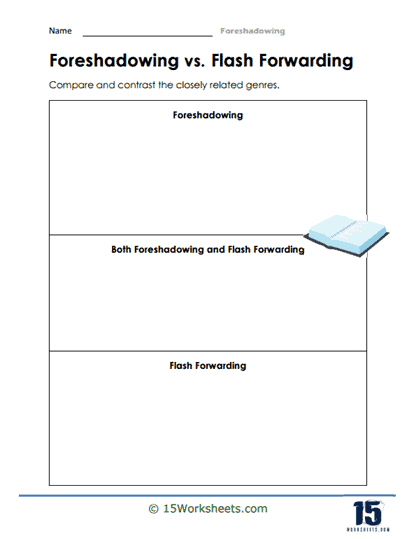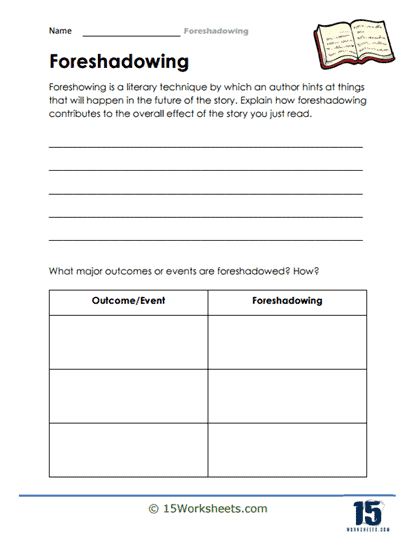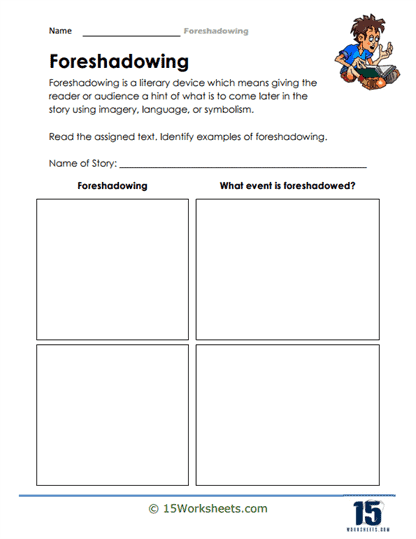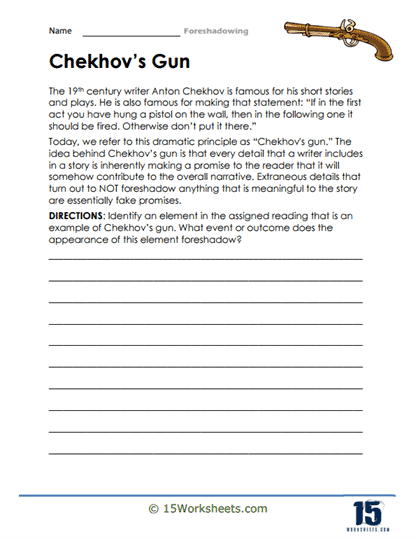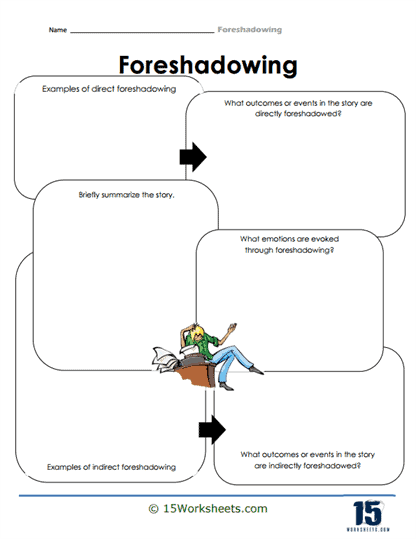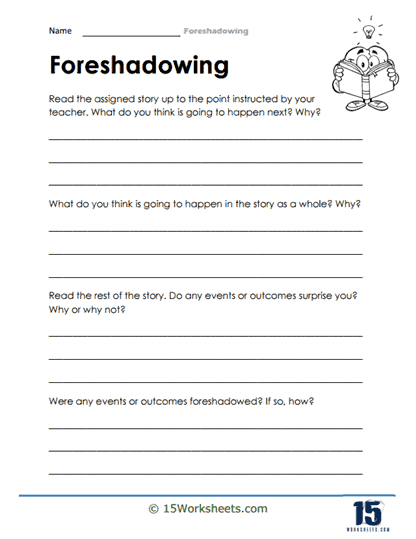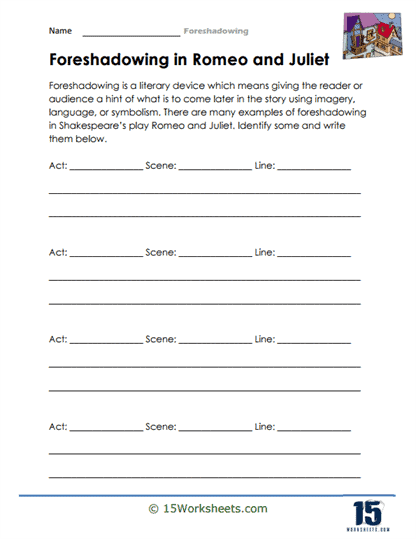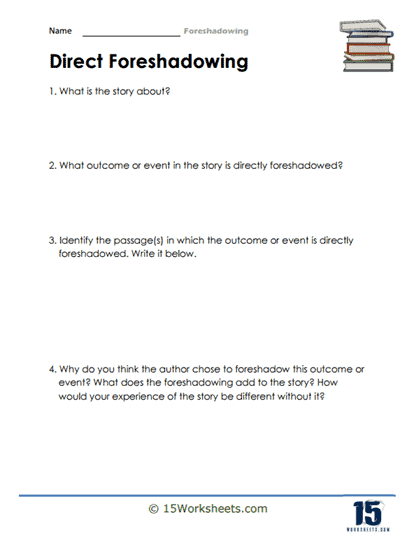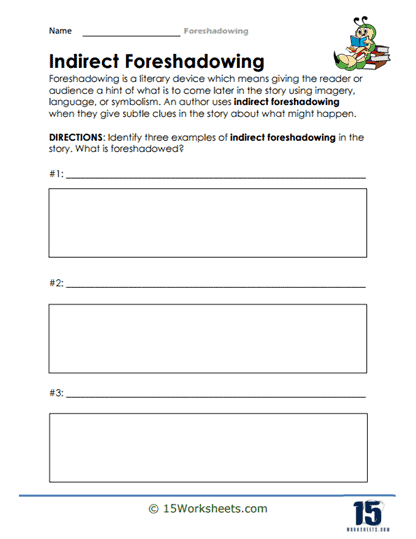Foreshadowing Worksheets
All About These 15 Worksheets
Foreshadowing, a literary device used by authors to provide hints or clues about future events in a story, adds depth, suspense, and intrigue to narratives. Understanding foreshadowing not only enriches students’ reading experiences but also enhances their ability to analyze literature, recognize storytelling techniques, and anticipate plot developments. This collection of 15 worksheets is designed to introduce students to the concept of foreshadowing, helping them appreciate its importance in literature, identify its usage, and apply it effectively in their own writing and critical analysis.
What Are Foreshadowing Worksheets?
Foreshadowing worksheets are designed to help students understand and recognize the literary technique known as foreshadowing. Foreshadowing is a method used by authors to give their readers hints or clues about future events in the story. It helps build suspense, prepare the reader for what’s coming, and make a narrative more believable by setting up the necessary groundwork for future events.
These worksheets would be filled with exercises to help students grasp this concept and see how it works in various contexts. Here are some examples of the types of activities you might expect to find on a foreshadowing worksheet:
Identification – One of the most basic exercises could involve reading a passage and identifying whether or not it contains foreshadowing. If it does, the student would be asked to explain what future event is being hinted at.
Understanding the Impact – Some exercises might ask students to analyze how foreshadowing affects the plot of a story, or how it influences their reactions as readers. They might need to think about how the story would be different without the foreshadowing.
Creating Foreshadowing – For a more advanced exercise, students could be asked to write a short paragraph or story that uses foreshadowing. This helps students understand not just how to identify foreshadowing, but also how to use it effectively in their own writing.
Comparing Across Works – Some worksheets might contain exercises that require students to compare and contrast the use of foreshadowing in different works of literature, or even different media like books, movies, and TV shows.
These types of exercises can help middle school students gain a deep understanding of how foreshadowing works and why authors use it, ultimately enhancing their reading comprehension and their writing skills. By working on foreshadowing worksheets, students are equipped with the ability to predict and infer information, which are essential skills in reading and daily life.
What is the Literary Device of Foreshadowing?
Foreshadowing is a pivotal literary device that allows an author to provide hints or clues for future events in the story. It creates anticipation in the reader’s mind about what might happen next and thus adds an intriguing element to a storyline. Foreshadowing is often used to predict death or doom, signal upcoming events, or hint at the resolution of a story’s conflict.
Defining Feature of Foreshadowing
The main defining feature of foreshadowing is its predictive nature. It’s a mechanism to create suspense and prepare the reader’s mind to expect certain outcomes. This clever use of “clue-dropping” sets the stage for the unfolding of events or plot twists. Foreshadowing can be subtle or direct, depending upon the author’s style and the genre of the work.
Examples of Foreshadowing in Literature
“Of Mice and Men” by John Steinbeck
In Steinbeck’s classic, foreshadowing plays a significant role in creating the tragic end of the story. Early in the book, Candy’s old, useless dog is shot, serving as a symbol for what will happen to anyone who has outlived their purpose. This foreshadows the death of Lennie, a character with a child-like mindset but the strength of a grown man, who accidentally kills a woman. Recognizing the repercussions this could have for Lennie, his friend George makes the difficult decision to euthanize him as a way to spare him a worse fate. This is a poignant example of how foreshadowing can be used to prepare the reader for tragic events.
“The Lord of the Flies” by William Golding
In this novel, the author uses foreshadowing to give readers a hint about the disintegration of order and civilization among the stranded boys on the island. For example, early in the novel, the boys enjoy their life without grownups and create their set of rules. Still, the initial fun and games eventually deteriorate into savagery, hinted at when the choir boys let the fire go out to hunt, leading to a ship passing by without noticing them. This instance is the first significant signal of their slide into savagery.
“Harry Potter and the Sorcerer’s Stone” by J.K. Rowling
Rowling’s Harry Potter series is rife with instances of foreshadowing. In the first book, Harry’s scar hurting when Professor Quirrell is near is a subtle hint of their connection, revealed dramatically at the end when it’s unveiled that Quirrell has been hosting Voldemort, Harry’s arch-enemy, all along. This example shows that foreshadowing can be used subtly, with small hints that may not even be noticeable until the reader knows the story’s outcome.
Exploring the world of foreshadowing through this collection of 15 engaging worksheets offers students an opportunity to develop essential skills in reading comprehension, literary analysis, creative writing, critical thinking, and an appreciation for the art of storytelling. Foreshadowing is a powerful device that enhances both the reading and writing experience, providing readers with anticipation and writers with tools for crafting compelling narratives.
By engaging with these exercises and activities, students not only enhance their academic abilities but also gain valuable tools for success in their literary explorations and creative endeavors. The benefits of studying foreshadowing extend far beyond the classroom, empowering students to be more discerning readers, skilled writers, and insightful analysts of literature in all its forms.

